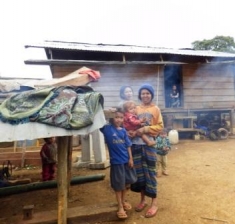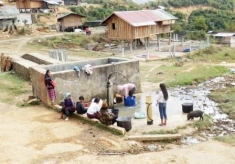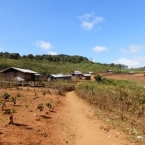People of the Sekaman River Prioritize River Restoration and Reparation
Over the past few weeks, I have been visiting communities in southern Laos along the Sekaman River. This river flows southwards from the mountainous Dakcheung region near the border of Vietnam to the Sekong River, a major tributary of the Mekong River that crosses into Cambodia. Ethnic minority communities along the Sekaman have depended upon the forests, rugged hillsides, and free-flowing river for generations. Despite the fact that the people of this area are typically seen by the government as ‘backwards’ and in need of integration into the state’s plans for large-scale export-oriented development, their adaptation to the landscape and their vibrant cross-border trading network belies this claim. Villagers say they are strongly rooted on the land of their ancestors and continue to practice subsistence farming and fishing. However, the central basis for their livelihood security is rapidly being undermined by a vast hydropower scheme spanning along both the Sekaman and the nearby Sekong rivers.
Under a priority investment agreement with the Government of Laos, Vietnam’s Viet-Lao Power Company (VLPC) has been awarded the exclusive right to build a series of dams along both rivers with the explicit purpose to export power to Vietnam. Many of these dams are planned to be connected to the proposed Lao PDR-Vietnam Power Interconnection (Hatxan-Pleiku) Project, which is featured in the Asian Development Bank’s Greater Mekong Subregion (GMS) development strategy. VLPC’s major shareholder, the Song Da Group, has recently finished the construction of the Xekaman 3 Hydropower Project in Dakcheung. Now plans to build two dams downstream (Xekaman 2A and 2B), along with four dams upstream (Xekaman 4A and 4B and Dak E Muele A and B) are advancing.
The people of the Sekaman River should have access to information in their own minority languages about what is happening. They should have access to compensation for the loss of ancestral lands and any land used for roads or project construction. If they are forced to abandon their land or homes along the river because of rising river levels or the filling of the reservoir area, they should have access to livelihood restoration programs to ensure their living conditions and food security are not further jeopardized. A grievance mechanism by which villagers can have their concerns addressed should also be in place. Compliance with such minimal standards are outlined in Lao laws and the environmental and social standards required by the Asian Development Bank. But as far as I can see from my site visit, and as confirmed by villagers’ accounts, VLPC along with the Song Da Group, have a dismal record to date. As they advance with building dams along the Sekaman River, these companies seem to be prepared to leave a trail of dispossessed and uncompensated villagers who now remain at a loss for how to regain a self-reliant livelihood.

Amongst the people who I met living in the communities upstream and downstream of the Xekaman 3 Hydropower Project, I heard open expressions of frustration with the lasting impacts of the dam building process. The Triang ethnic minority people I met say that prior to beginning construction of the Xekaman 3, Song Da never informed them about the locations where the river levels would fluctuate or flood, nor that as a result of the dam, the populations of migratory fish in the river would disappear.
Villagers can no longer rely on the river as a source for potable water due to changes in flow and the concentration of debris. Migratory fish have since disappeared. As a result of this dramatic decline of an estimated 90-95% in fish catches, villagers report that it is no longer worthwhile to go out fishing with traditional nets. Meanwhile, they have lost land along the riverbanks that they used to cultivate communally, without ever being compensated.
Now, the company appears to be turning a blind eye to villagers’ concerns. For example, village headman representing hundreds of families commonly explained to me that Song Da had not addressed any of their concerns about unpaid compensation for lost land or requests for support for the installation of basic water pumps to replace lost sources of potable water. In fact, some village headmen – who speak the Triang language of their ancestors – recounted the humiliating situation of being told by company personnel that if they could not present their requests in Vietnamese, Song Da would not respond. Now, many people say they are worried about what will happen if Song Da and VLPC build more dams upstream and downstream from the site.
One headman explained this sense of apprehension to me by saying:
“We don’t know yet what kind of problems there will be in this village because of [the planned] Xekaman 4 Dam. We’ve heard Song Da is also building this new dam. They never told us what would happen to us when Xekaman 3 was built. We don’t know if they just are not telling us about Xekaman 4, and if there really will be serious problems here. But what we do know for sure is that it is not a good idea for there to be another dam on the Sekaman. We, the village people, lose so much and never benefit. This company [Song Da] doesn’t compensate people for their losses, and they make promises that aren’t ever kept.”
Another headman in a village further upstream echoed this feeling when he said:
“We are very worried about the impacts of these dams because everyone has seen the problems caused by Xekaman 3. We do not want the land we rely on flooded! People have already suffered once from that dam. Other dams would cause more problems for us living here in this village. We rely on the fish, the snails and other wild foods and don’t want to lose these because of Song Da’s plans [to build more dams].”
In each community I visited, villagers asked if Vietnamese and other international organizations would help advance their requests to the Song Da Group, and to any related planners and financiers. I am left wondering what it will take for the Government of Laos and the Asian Development Bank to see the costly implications of such ‘frontier development’ along the Sekaman and Sekong rivers. It is not only the food and livelihood security of thousands of ethnic minority people in southern Laos that is at stake, but also that of neighbouring communities in Cambodia and Vietnam. Only when they are prepared to take the villagers’ experiences of loss due to the Xekaman 3 Dam seriously, will a shift away from further destructive investments be possible.










